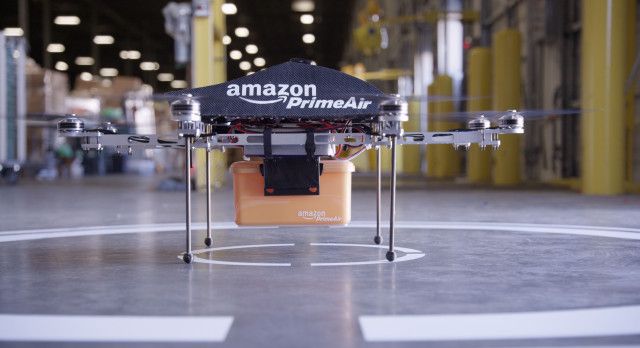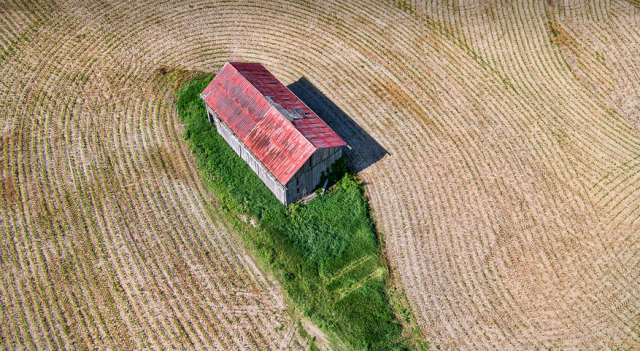How would you feel if seeing and hearing drones (Unmanned Aerial Vehicles) flying overhead became the norm? In many sectors – both profit and non-profit – this future isn't as distant as you may think. Here are seven industries that are set to be revolutionized by this burgeoning technology.
With any technological advancement, there’s always a hearty dose of scepticism and caution thrown into the surrounding debate. Think about the worries surrounding 3D printing, and how the paranoid ranks shudder at the thought of 3D printed sub-machine guns lining basement walls. Those same ranks cower at the thought of drones buzzing overhead, like an Orwellian nightmare.
But I’d like to introduce you to seven industries that are ready and braced to be (mostly positively) impacted – if not revolutionized – by the technological progress that’s surrounding drones right now. While you're reading, why not think about how drones might impact your own industry?
Shipping
You've likely already come across the recently announced Amazon Prime Air, as it sent more than just a ripple of excitement around the globe with its hints at possible sub-30-minute delivery times. Close your eyes, and imagine drone after drone wizzing around the residential parts of your local village, carefully placing your recently ordered book on your patio just minutes after you hit ‘One Click Purchase’.
If Amazon (or any other company – UPS delivery drones are apparently under development, too) can negotiate the tumultuous waters of air-space regulations, theft of mighty-expensive drones (word is that each of these delivery drones could be worth $30,000+), and mischievous kids with catapults and oversized fishing nets, then witnessing a quadcopter descending into your garden with a six-pack of Fosters isn’t as far fetched as some might think. After all, the hardware is already there.
Agriculture
If you're reading MakeUseOf, the chances of you toiling the fields every day are pretty slim. But for millions of workers in the agricultural industry, huge amounts of time is spent venturing the land, checking the quality and ripeness of crops, the security of fences and walls, water-levels, and more. The industry is on the brink of becoming one of the first to embrace drone technology in order to sky-rocket efficiency.
As mentioned in this ksat.com video on the agricultural industry's future, quad bikes are (some may say sadly) beginning to be shunned. As their replacement, drones are “fast becoming a farmers best friend. Flying over crops, it collects images, quickly relaying the condition of a farmer’s harvest down to a single plant. You can fly over a section of land, 1mile x 1mile (640 acres) in about 18 minutes at 1-inch resolution”.
Agricultural applications of drones fit into three main categories: scouting, mapping and aerial spraying. Given the relatively low adoption rate up to this point, there’s huge scope for companies to gain a real advantage by making use of this technology early on.
This isn't likely to lead to cheaper fruits and vegetables on supermarket shelves just yet, though. With farmers' profit margins being tightly squeezed at present, any cost savings will likely either be gratefully accepted by the farmers themselves, or added to the margins of the larger supermarkets. Either way, this usage of drones will hopefully manage to make the labor of farmers that bit easier – opening up spaces for this effect to be replicated in other physically demanding professions.
If you work for the fire department, imagine a drone spraying water over a burning building. If you work on a building site, imagine using a drone to check the safety of scaffholding instead of needing to do this by hand.
Law-Enforcement
In the ever-encompassing name of ‘combating terrorism and crime’, police forces (primarily in the Western world) are increasingly spending sections of their budgets on drones to help with crowd monitoring and deterrence.
In the past, this hasn’t always gone according to plan. In the relatively ‘early’ days of this usage of drones, a Merseyside (UK) police force sadly, but also rather humorously, lost a £13,000 drone in the river Mersey after it ran out of power. A spokesman said “during its use officers recognised certain technical and operational issues, including staff training costs and the inability to use it in all weather conditions”.
As the technology develops, however, these issues are gradually being ironed out, with drones being usable in more and more balmy weather conditions. The speculative YouTube video above shows what a “spy in the sky” state may develop into has seen plenty of interaction, suggesting that law-enforcement drones could even potentially monitor ‘stress levels’ in a localised area – to predict the likelihood of criminal activity (or possibly/accidentally detecting your 'chronic overworked' levels while you struggle to keep up at the office). Wouldn't that be fun?
Although in our lifetime things may not go this far, it’s not a hard leap for the imagination to see drones becoming an even more irreplaceable part of law-enforcement in the coming decades. Whether that’s for better or worse remains to be seen.
But who knows. Next time your wallet is stolen, and you see the thief being chased down the road with a drone fast on his/her heels, you may come to appreciate this use of technology.
Search and Rescue/ Healthcare
http://www.youtube.com/watch?v=yy89vxX088Q
One of the main issues for healthcare and emergency response teams is getting life-saving equipment and treatment to the people who need it as quickly as possible. As drones become more and more cost effective, the possibilities to reach those most in need are exponentially growing. You may have even been in a situation yourself in which a drone could have been of use not only in treatment, but also diagnosis, of an emergency.
As an example, imagine a drone being used swiftly after an avalanche, to drop emergency supplies and help with the search and rescue effort. If everyone is uncovered without problems (thanks to the help of the drone), there's no need to call out for a helicopter – saving the local resort a small fortune. But there's still quick and suitable response.
On a similar note, a recent grant was awarded by GrandChallenges.Org which is being used to “develop Unmanned Aerial Vehicles (UAVs) that can be deployed by health care workers via cell phones to swiftly transport vaccines to rural locations and alleviate last-mile delivery problems and improve cost, quality, and coverage of vaccine supplies”. A noble effort if ever there was one.
Along a similar line, Height Tech is developing a drone that can deliver a defibrillator to hard-to-access areas such as golf-courses, mountains, and coastal areas. As within law enforcement, drones look set to take a leading role in future developments to ensure a rapid and ready response (that’s a fraction of the cost of a helicopter) to any emergencies that may arise, whether that’s an earthquake, or a Kendal-Mint-Cake induced hyper.
Filming and Photography
https://www.anrdoezrs.net/links/7251228/type/dlg/sid/UUmuoUeUpU57204/https://vimeo.com/83187924
My friend and blogger Niall Doherty recently posted a link to amazing video of big-wave surfing (above), filmed by aerial photographer Eric Sterman with a GoPro camera attached to a DJI quadcopter – a setup that likely cost no more than $2000. And with professional companies, such as Liverpool-based Ironbird, producing drone-captured videos of the highest calibre, we’re able to see what’s really possible.
In the future, we may see low-budget productions – with producers, directors and amateur film-makers – creating truly spectacular material without spending the tens of thousands of dollars for hiring a helicopter. While we can't expect movie tickets to get cheaper, we can expect to see more amateur shootings crop up on the net.
That’s not to say that things can’t go wrong. Back in 2013, well-known photographer Chase Jarvis infamously lost control of his drone setup, leading to a chilly crash into an Icelandic Sea.
http://www.youtube.com/watch?&v=Cvu937rXvj1Jc
But with the right training, experience and caution, the aerial photography possibilities are both exciting (and sometimes a little creepy; check out this 'stalking' drone to see what I mean).
Who knows, within a few years, we may all be taking selfies with miniature drones that we carry around!
Real Estate
What with mapping, auto-pilot and recording functions on drones becoming so advanced (and often affordable), their potential is now starting to be realised in the real estate industry. High-resolution real estate footage of luxury homes is being recorded, both indoors and out, to help increase sales conversions for high-end realtors.
Before you know it, you'll be gliding round your next house, holiday apartment, hotel or AirBnB rental from the comfort of your own smartphone.
But sales and marketing are far from the only usage for drones in real estate. With very simple setups, surveyors and inspectors can assess structures, damage, and problem spots so as to provide diagnoses and quotes without needing to ‘get up there’ themselves, simply by following the footage in real time on a laptop or iPad.
With similar technologies, project managers of new builds can oversee real estate developments, while mapping software can create 3D visualisations of acquired land for planners and architects to work with.
Scientific Research/Conservation
A couple of years ago, I enjoyed sitting through a TEDx talk by Dr. Serge Wich about his organization ‘Conservation Drones’. Wich and his team travel around the globe, helping with conservation efforts ranging from producing anti-poaching videos, to the mapping of rainforests and the tracking of wild animals.
Since then, it seems the company, and the idea, has gone from strength to strength, showing that the demand for this cost-effective, highly customizable option for conservation is anything but small.
These drones can map an area of land far faster than a group of people – and` can track animals using GPS quickly and easily – in the most remote areas on the planet. Consider what may be achievable – in a fraction of the time, for the fraction of the cost – when it comes to conservation efforts. These are exciting times for university research teams, or anyone looking to enter this space – especially as we’re starting to see the cost of quality drones become lower and lower.
In fact, the uses above are just a fraction of the more obvious ideas about what drones will be used for in the future. As was the case with the internet, in the early consumer stages, no-one was quite sure what the technology would really be used for on a larger scale. Who’d have thought we’d be posting wine reviews that last just 15 seconds, sharing our couches with complete strangers or spending our waking hours looking at pictures of cats overlayed with captions?
The same is true for drones. It’s a pretty sure bet that they’ll continue to integrate into our lives more and more, but expect to be surprised by some of the uses that will actually come into fruition, especially with the creativity that can be demonstrated by hardware such as Raspberry Pi’s, and all the fanciful things they can make possible.
What other industries do you think drones will become a large part of?
Image Credits: John Biehler via Flickr, PrimeAir by Amazon, Farmhouse by Frederic Rivollier via Flickr



